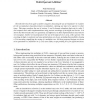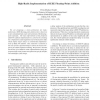36 search results - page 3 / 8 » Multi-operand Floating-Point Addition |
TVLSI
2008
13 years 6 months ago
2008
Recently, it has become possible to implement floating-point cores on field-programmable gate arrays (FPGAs) to provide acceleration for the myriad applications that require high-p...
ERSA
2006
13 years 7 months ago
2006
Floating-point summation is one of the most important operations in scientific/numerical computing applications and also a basic subroutine (SUM) in BLAS (Basic Linear Algebra Sub...
SIAMSC
2008
13 years 6 months ago
2008
In this Part II of this paper we first refine the analysis of error-free vector transformations presented in Part I. Based on that we present an algorithm for calculating the round...
ASAP
2002
IEEE
13 years 11 months ago
2002
IEEE
Recently there has been quite a number of papers discussing the use of redundant 4-to-2 adders for the accumulation of partial products in multipliers, claiming one type to be sup...
ARITH
2005
IEEE
13 years 11 months ago
2005
IEEE
We are proposing a micro-architecture for highperformance IEEE floating-point addition that is based on a (non-redundant)high-radix representation of the floatingpoint operands....


